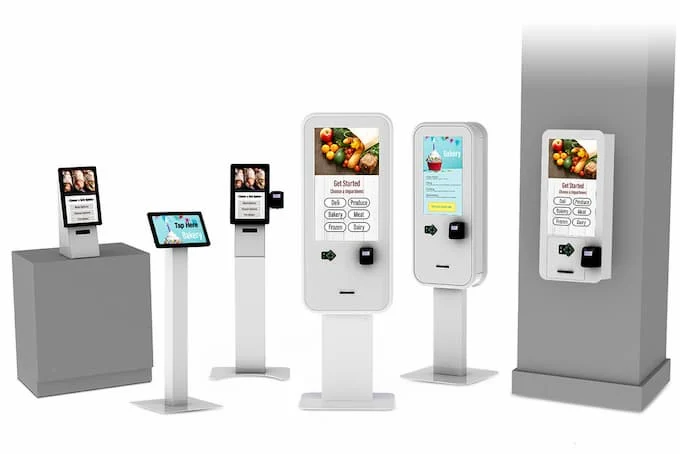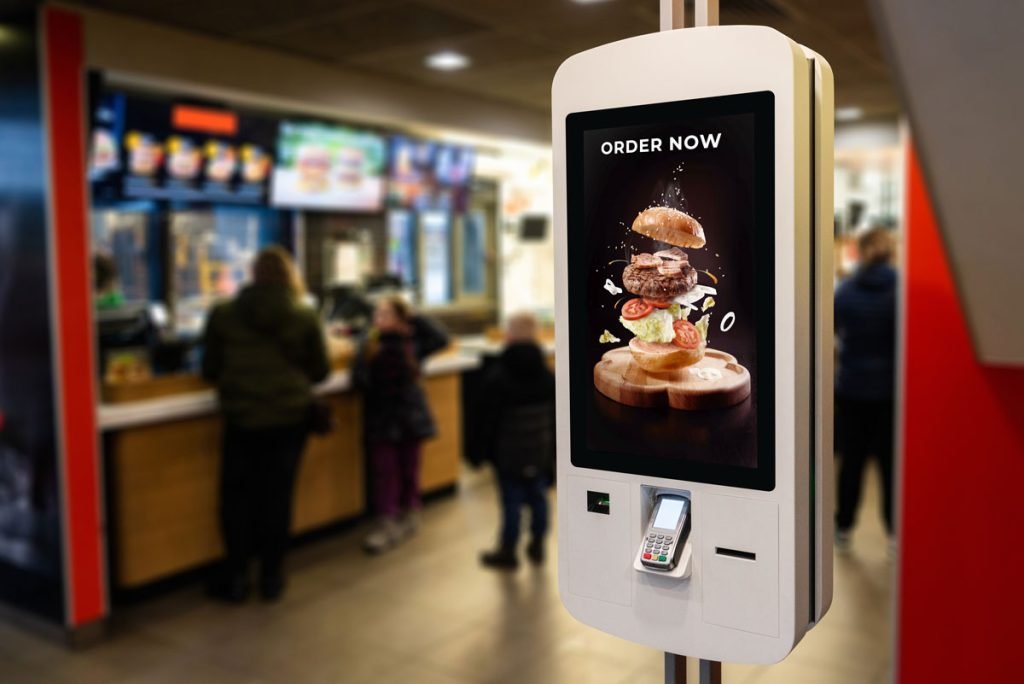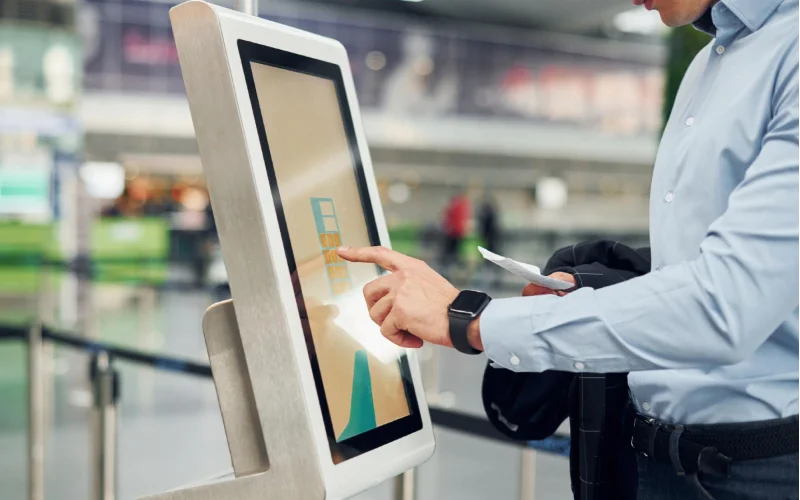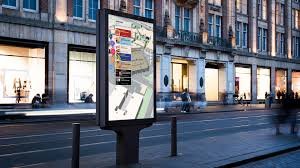
How Self-Service Kiosks Work: Functions, Benefits & Applications
Self-service kiosks are quickly becoming a popular choice in many fields, including restaurants, stores, airports, and hospitals. Customers can place orders, buy things, or do tasks on their own at these interactive terminals without having to talk to a person. In this blog, we’ll learn how self-service kiosks work, what they do, what benefits of self service kiosk are, and how they are used in real life in stores, hotels, hospitals, and more.

What is a self-service kiosk?
Self-service kiosks, sometimes known as self-service point of sale (POS) systems, are interactive touchscreen devices that let clients make purchases without help from employees. Customers may explore products, place orders, and make payments on their own thanks to its hardware and software components.
A screen device that is mounted to surfaces like walls, counters, or floor supports is the hardware element of a self-service kiosk. A kiosk program serves as the software component, enabling you to create an ordering process that works for your company.
Types of Self-Service Kiosk
Self-Order Kiosk

A restaurant or takeaway self-ordering kiosk lets consumers place orders and pay.
Fast-food businesses love these kiosks for managing large client numbers. Customers can peruse digital menus with photographs or videos of meals to make faster, more informed decisions.
Self-ordering kiosks let you add toppings, remove items, and choose quantity sizes. Once a purchase is confirmed, clients can pay with credit, mobile, or gift cards. The kiosk sends the order to the kitchen, streamlining and reducing errors.
Self-ordering kiosks for restaurants can boost revenues by encouraging upsells (“Would you like to add fries?”) and cut costs by reducing counter staff. Faster, more tailored service improves customer happiness.
Queue Kiosk

Food courts and cafes with heavy foot traffic benefit from queue kiosks.
When consumers come, these kiosks assign a digital queue number to control traffic. Customers can relax and wait for their turn on a screen or notification system instead of standing in huge queues. These kiosks help reduce wait times and counter overcrowding.
They ensure fair and orderly service by streamlining queue management, reducing confusion and irritation. Queue kiosks support mobile apps so clients can check their queue status remotely. This improves ease and consumer happiness during busy hours. They also help restaurants and F&B operators enhance operational strategy and staff allocation by analyzing client patterns.
What are the benefits of Self-service kiosks?
Free up staff time
Self-service kiosks allow customers to place orders without staff. This frees up staff for other vital human-interaction-based tasks.
A self-service kiosk may be useful if your firm has a low workforce or, like many eateries, is paying more for staff due to increased minimum wages.
Enhance space management
Self-service kiosks save counter space. Self service Kiosk may be mounted on walls, counters, or floor stands, so you can adjust it to meet your restaurant or store without any structural alterations. Consider posting ‘Order Here’ signage near your self-service kiosk to direct traffic.Improve client control and experience
Self-service kiosks let clients browse menus, personalize orders, and pay without staff interaction, making them suitable for independent diners. Instant order processing reduces human errors and speeds up service, while built-in upselling tools enable clients explore add-ons at their own leisure.
Customers can select things and check out faster in self-service mode because they have full control over their orders. This can reduce order errors and wait times in noisy restaurants, improving customer satisfaction.
Increase revenue and cut costs.
Adding a kiosk to your restaurant or business can boost revenue. First, self-service kiosks allow clients to order additional things or make specific requests anonymously.
Second, self-service kiosks let you carefully design upsells and other incentives for clients. Square Kiosk and other ordering platforms use visual menus with upselling tools to recommend extra items depending on a customer’s order. This can boost check averages by promoting sides, drinks, and bundled meals. Restaurant owners should be pleased, since data reveals that self-service kiosk clients spend 10-30% more than restaurant staff customers.
Higher profit margins and speedier transactions can improve customer satisfaction for restaurants with fewer overhead and better order accuracy. Long-term savings and revenue growth justify self-service POS system investments.
Improve consumer insight
Self-service kiosks can reliably track client activity and preferences through top-selling items and revenue. This data can help you personalize experiences.
The drawbacks Of Self-service kiosk
Though self-service kiosks have benefits, restaurants should expect issues:
Human support may be needed for older or disabled clients who have problems utilizing touchscreens.
Reluctance from traditional orderers requires assistance and explicit instructions. This is why in-person order collectors need genuine staff.
Careful planning, including regular maintenance, inclusive design, customer education, and staff support for those who want it, can reduce these impediments.
Self-service kiosks: How they work?
A self-serve kiosk is a touchscreen terminal that lets people browse, customize, and complete transactions on their own. The kiosk’s software is easy to use, so it can respond to touch and show menus or options for easy navigation. Customers can pick out items, change their preferences (like size or toppings), and then pay using an integrated system like a card reader, NFC (for mobile payments), or a cash acceptor.
After the self-service POS system confirms payment, the kiosk processes the order and often sends it to a backend system (like an inventory database or kitchen) and prints or sends a receipt electronically. The whole process, from choosing to finishing, is designed to be quick and easy, with little help needed from employees. This boosts productivity for both clients and businesses.
How to use a self-service kiosk
Self-service kiosks allow customers to place orders, check out items, and access information by tapping the touchscreen and following the prompts. Self-service kiosk applications include:
- Menu customization, specific demands
- Using discounts, scanning, and paying at self-checkout
- Checking prices, specs, or inventory
- Booking flights and printing boarding passes
The following industries employ self-service kiosks:
- Restaurants (fast food, cafes)
- Retail stores (supermarkets, clothing shops)
- Health and beauty (salons, fitness studios)
- Transportation (airports, train stations)
- Healthcare (hospital check-ins, pharmacy pickups)
What’s the price of a self-service kiosk?
Restaurant self-serve kiosk prices depend on features, hardware quality, and software complexity. Basic devices cost $1,000–$2,500, while complex systems with huge touchscreens, integrated payment processing, and custom branding cost $3,000–$7,000+.
Installation, maintenance, and software licensing may cost more. Self-service kiosks are a cost-effective update for many firms due to labor savings and improved sales. In addition, leasing and subscription software can lower upfront expenditures.
Digital vs interactive kiosks: What is the difference?
These concepts may seem synonymous: “digital kiosk” and “interactive kiosk”. These kiosks differ in important ways.
Digital kiosks display one-way information in digital format. It could be static graphics, movies, or scrolling text. Although comparable to digital signs, they commonly display menus, navigation directions, or product information.
Interactive kiosks emphasize two-way communication and more user participation. They let users to interact with presented content via touchscreens or other interactive elements. This may entail ordering, paying, or choosing from a menu. Non-interactive kiosks are less dynamic and engaging than interactive ones.
In conclusion, all interactive kiosks are digital, but not all digital kiosks are interactive.

Self-service kiosk FAQs
What is the purpose of a self-service kiosk?
A self-service kiosk is a tablet or touchscreen computer that lets a consumer get information or services without having to talk to a human. Adding self-service kiosks can help a firm grow faster and more efficiently while also lowering costs.
How does a kiosk machine work?
The self-serve kiosk found today in many restaurants is an interactive, automated device that allows customers to place orders and make payments through a touchscreen.
How does self-serve work?
In self-checkout systems, the customer is typically required to: Scan product barcodes where these exist. Weigh products (such as fresh produce) without barcodes and select the variety on a touchscreen display.
What are the disadvantages of using kiosks?
Disadvantages. 1. Self-service kiosks may keep away customers who prefer to deal with actual people rather than machines. These kiosks sometimes may be difficult to operate for those who are not tech-savvy or because they’re not kept in good working order.
What is the difference between a kiosk and a machine?
While all self-service kiosks are machines, not all machines are kiosks. Kiosks are interactive and user-facing, designed for self-service, while “machines” is a broader term that includes any mechanical or automated device, often without any user interaction.











